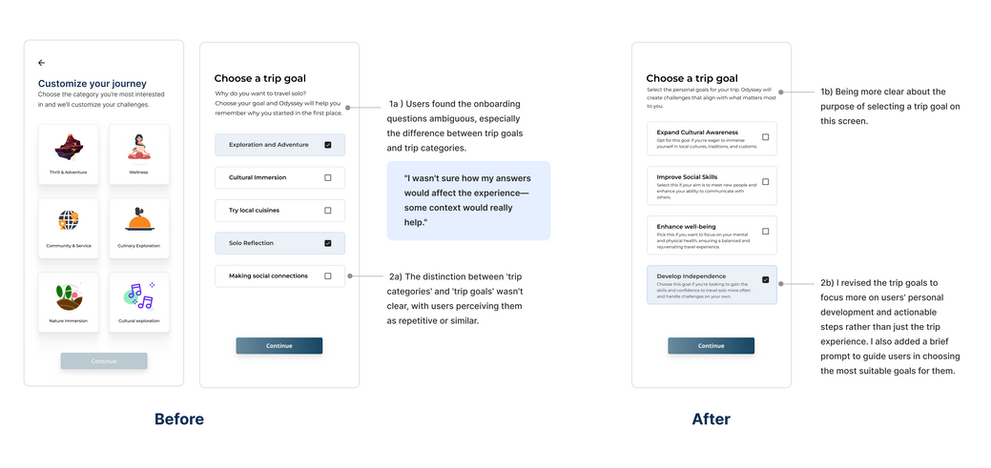top of page

tl;dr
Odyssey is a mobile app that empowers first-time solo travelers to build confidence through gamification. With features like personalized onboarding, custom challenges, and a supportive travel community, Odyssey transforms solo adventures into exciting and rewarding experiences.
Key Features
.png)
Personalized Onboarding

Customized Challenges

Rewards & Badges

Travel Community
The Problem
First-time solo travelers often feel overwhelmed by fear and uncertainty, making it difficult for them to embrace and enjoy solo adventures.
The Process

phase 01
Research
Secondary Research
White Paper Research
Behavior Analysis
Primary Research
User Surveys
User Interviews
Competitive Analysis
secondary research & insights
Let's dig deeper into the problem
As someone who loves solo travel, I’ve often felt the excitement of adventure overshadowed by the fear of loneliness and uncertainty.
Curious if others felt the same, I conducted secondary research, diving into travel forums, industry reports, and articles to validate if this issue was as widespread as it felt personally.
Key Insights
Loneliness is the biggest hurdle.
Travelers miss the comfort of human connection during their journey.
Personal growth drives motivation.
Most solo travelers see these experiences as an opportunity for autonomy, ticking off bucket-list goals, and self-reflection.
Journey over destination.
Travelers value enriching moments and emotional growth more than simply reaching a location.
Why is this a big problem?
81% of first-time solo travelers report being eager to travel again within the next year. This highlights a critical question—why is it just the first trip that holds them back?
Aren't they missing out on the most transforming experience of their lives?
primary research & insights
User Interviews and Surveys
My next goal was to uncover deeper emotional barriers and confirm whether fears like loneliness and lack of confidence were universal- and that's why my next step was constructing a survey and user interviews.
Research Group (survey + interviews)
20
Novice solo- travel enthusiasts. (no solo travel experience)
7
Experienced solo travelers (solo traveled to 19+ countries
Key Findings
Fear of loneliness
17/20(novice)
users perceived solo travel as less fun and satisfying.
Lack of Confidence
18/20(novice)
users cited lack of confidence as their biggest barrier.
Personal growth
7/7 (expert)
travelers shared how their confidence grew with each trip
let's go deeper
Behavioral analysis from studies
With the research complete, I wanted to go deeper—understanding why my users behave the way they do and what influences their decisions.
To achieve this, I analyzed behavioral studies on solo travel, including findings from research papers and reports.
Key Findings

They are naturally reflective and value learning from every experience.

They value their freedom and prefer flexible itineraries.

They value community engagement to share their stories.
studying the market
Competitive Analysis
With insights from user research in hand, I wanted to explore how existing platforms address—or fail to address—the needs of solo travelers. I analyzed indirect competitors to uncover gaps and opportunities for innovation.

Most platforms prioritize social connections but neglect personalized experiences and tools that cater to solo travelers’ unique needs. This analysis informed the design opportunity that combines personalization and community support—creating a solution built specifically for solo adventurers.
phase 02
Define

Affinity Mapping

Empathy Mapping

How Might We's
bringing it all together
Affinity and Empathy Mapping
To make sense of the data, I used Affinity Mapping to cluster insights into themes like motivations, fears, and strategies. These themes were then translated into an Empathy Map, capturing what users say, think, feel, and do.

Solo Travel_Affinity Map

Empathy Map

Solo Travel_Affinity Map
1/2
Key challenges emerged

Users see solo travel as less enjoyable than group travel due to lack of company.
First-time solo travelers often feel overwhelmed about planning and lack confidence in their ability to enjoy alone.

Solo travel often feels isolating, and users crave connection and support during their journeys.
While synthesizing the data, one realization stood out. This insight was pivotal—it shifted my approach from fear elimination to confidence-building and shaped the foundation of my design strategy.
An insight that changed the direction of my design approach
Overcoming fears should be the outcome, not the focus. Users don’t need to tackle their anxieties head-on; instead, the solution must guide them through small, manageable steps that build confidence over time.
defining the goals
The Main Challenge
This realization led to reframing user needs into a central guiding question.
The Challenge
"How might we help first-time solo travelers build confidence through small, meaningful steps that make their journey feel personal and rewarding?"
Based on the core design challenge, I broke the problem into actionable goals to create a design strategy that would help guide my designs decisions and ideas.
Goals + Strategy

phase 03
Ideation
SCAMPER
MOSCOW ANALYSIS

TED TALKS
from sketches to tangible designs
Initial design concepts
After identifying that overcoming fears should be a natural outcome of gradually building confidence, I explored multiple ideation techniques—SCAMPER for creative innovation, MoSCoW Analysis to prioritize features, and inspirational content like TED Talks to stay user-focused.
To translate these ideas into tangible solutions, I developed three key concepts and validated them with users through concept testing.
.jpg)
Why I had to discard Concept-2
The mentorship concept, while appealing, was discarded as it digressed from the goal of fostering self-guided growth and confidence. Users raised concerns about sustained engagement, and incentivizing mentors proved challenging, making the concept unsustainable.
from feedback to refinement
Incorporating feedback from concept testing
Concept testing highlighted a universal need for personalization and self-paced progression. I focused on refining the strongest ideas based on user feedback.
phase 04
Design, Evaluate, Repeat
EXPERT EVALUATION
TESTING WITH REAL USERS
refining the experience
Testing mid-fi wireframes with users
With a solid foundation from the previous phases, I entered the refinement stage to ensure the design addressed user needs effectively.
I conducted usability testing with 8 participants. Each user was guided through key tasks while I monitored their interactions and captured feedback. This helped uncover major areas for improvement.
bringing the vision to life
Final design solutions
Restating the core challenge
"How might we help first-time solo travelers build confidence through small, meaningful steps that make their journey feel personal and rewarding?"
#Challenge 1
Help users connect with their motivations and make the experience feel personal.
The Solution- Personalize your Solo Trip
Confidence starts with clarity. When users have a strong personal connection to their travel goals, they are more likely to feel empowered.
Applying Norman’s Emotional Design Principles, I crafted an onboarding flow that taps into users’ reflective levels by asking for specific travel goals - this fosters a sense of individuality and emotional engagement.
The onboarding process customizes challenges and suggestions based on the user’s goals, making the app feel relevant and personalized.
Now, they feel understood and excited about their journey, reducing their anxiety and creating a sense of purpose from the start.

#Challenge 2
Keep users motivated and engaged throughout their solo journey.
The Solution- Tick off destinations from your bucket list.
Based on the Goal-Setting Theory, tangible milestones like a bucket list motivate users to stay engaged and give their journey meaning.
It's placed prominently on the dashboard- by having it front and center, users are constantly reminded of their travel goals, which encourages regular engagement with the app.
Users can add places they want to visit, check them off as they go, and visually track their progress.
It provides a rewarding sense of accomplishment, reinforcing confidence with every milestone achieved.

#Challenge 3
Help users break down their trip into manageable, engaging tasks.
The Solution- Flexible Micro-challenges
I wanted to keep users excited and motivated, so I designed micro-challenges that become more difficult as they complete levels.
#Challenge 4
Reinforce a positive & fun perception of solo travel.
Using small rewards, like badges and points, after every task makes it fun and keeps them coming back. Each task provides immediate feedback through points and rewards, providing positive reinforcement to encourage continuous engagement and progress.
The Solution- Positive reinforcement after challenge completion.
#Challenge 5
Create a community where users can feel inspired and supported by others.
Sharing experiences helps users build connections with others who understand their journey, fostering encouragement and motivation.
The Solution- Share your progress with the travel community.
Challenges are displayed in a linear timeline, similar to a real itinerary, aligning with users' real-life mental models.
Users can swap challenges they don’t prefer for ones from other categories, giving them more control over their experience.
Users can share experiences, connect with others, and earn rewards for completing challenges.

Once you complete a challenge, the final task is to share your progress with the community.
Users can share travel photos, stories, and tips with other solo travelers, fostering support and inspiration.
Once you finish a level, let's say Level 1- Beginner, you unlock a digital passport with stamps from countries you visited. The idea is to have this passport mailed to you as a cherished memento that users can to reflect on their accomplishments and realize their growth during this whole journey.

what experts had to say
Feedback from experienced solo travelers
I presented my project at the Capstone Fair at Indiana University to a crowd of 200-300 people. Some experienced solo travelers were interested and gave some great feedback, which helped validate my design.

“The way the challenges are personalized based on experience level is clever. As a seasoned traveler, I liked that the app didn’t just give me basic tasks, but more engaging challenges that made me reflect on my trip and try new things...”
“I love how the goals and tasks fit together—it really makes the whole experience feel purposeful....”
“The bucket list is a great touch. It’s satisfying to add destinations and check them off.....”
the road ahead
Potential industry impact & future growth
If this project were shipped in the real world, here are some potential impacts and future scope.

Users can redeem points for discounts on travel-related services, boosting engagement through partnerships with airlines and travel brands.
The app’s gamification could drive a 20% increase in off-season tourism by offering rewards for visiting less crowded destinations.
retrospection
What I would do differently today
It's been 1 year since I worked on this solo project. During this year, I had a huge learning curve as a designer, especially about my problem-solving strategy & design decisions. Now, when I look at this project after a year, I see scope for improvement and here's what I would focus on and do differently for this project today.
More Usability Testing
Testing with a broader, diverse user group would uncover hidden pain points and improve the design’s inclusivity.
Enhanced Visual Design
Refining visual hierarchy and consistency would create a more polished and cohesive experience
Considering Constraints
Accounting for budget constraints early would have aligned the design with real-world feasibility.
Prioritizing Accessibility
Integrating accessibility checks would further support inclusivity and usability.
Improve UX Writing
Clearer, user-friendly copy would have made the interface more intuitive and engaging.
Consistency in Design Standards
Sticking to design guidelines would ensure a seamless and unified user journey.
looking back
Key takeaways and reflections
Balancing Motivation with Simplicity
One of my biggest takeaways was finding the right balance between motivating users with challenges and not overwhelming them with too much complexity. I learned that breaking tasks into small, manageable steps keeps users engaged and also boosts their confidence, making the overall experience less daunting.
Designing for Emotional States is Crucial
One of my biggest takeaways was finding the right balance between motivating users with challenges and not overwhelming them with too much complexity. I learned that breaking tasks into small, manageable steps keeps users engaged and also boosts their confidence, making the overall experience less daunting.
Anchor 1
bottom of page










